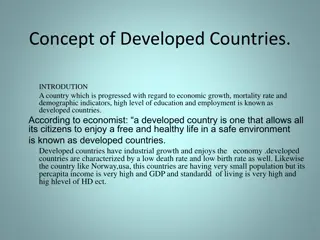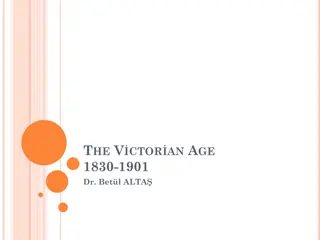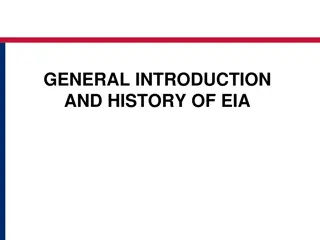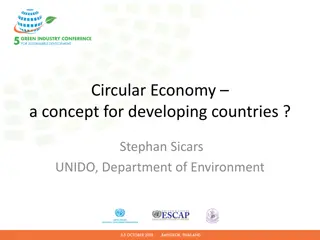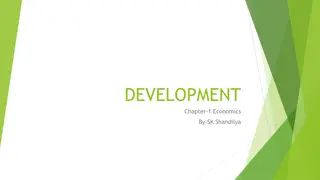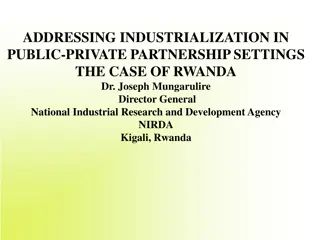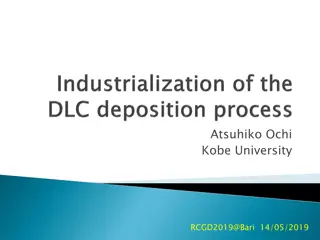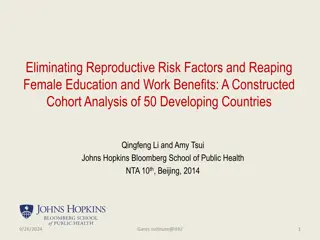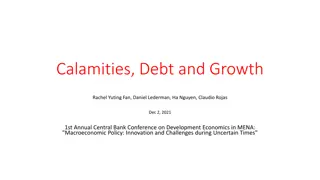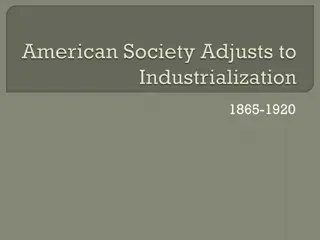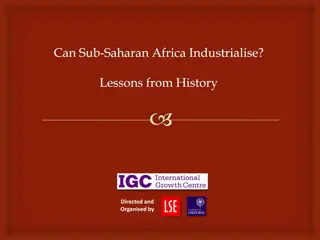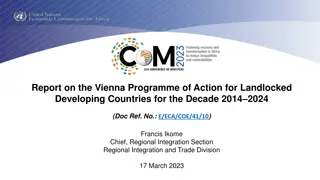Understanding Industrialization and Its Role in Developing Countries
Industrialization is defined as the process of economic development that mobilizes national resources to create a modern, diversified domestic sector capable of high growth. It plays a crucial role in transforming economies, creating job opportunities, and increasing income levels in developing countries. Industrialization is seen as a key strategy for achieving economic growth and improving living standards, addressing unemployment issues, and diversifying the economy. The manufacturing sector, with its economies of scale and dynamic nature, is crucial for driving economic development.
Download Presentation

Please find below an Image/Link to download the presentation.
The content on the website is provided AS IS for your information and personal use only. It may not be sold, licensed, or shared on other websites without obtaining consent from the author. Download presentation by click this link. If you encounter any issues during the download, it is possible that the publisher has removed the file from their server.
E N D
Presentation Transcript
Chapter Nine: Industrial policy After the completion of this unit, you will be able to: What industrialization and its role in LDC s? Know why government intervene in the economy in general particular, understand the industrial problems and the Ethiopian industrial policy and industries in development
9.0. Introduction According Development Organization (UNIDO), quoted in Dr. Eshetu Chole (1986:p.2), Industrialization defined as the process of economic development in which a growing part of the national resources is mobilized to develop technically up- to- date diversified domestic characterized by dynamic having and producing means of production and consumer goods and capable of assuring a high rate of growth for the economy as a whole and of achieving economic and social progress . to the United Nations Industrial economic manufacturing structure sector
This definition states that industrializing is a sustained process. It requires the application of modern science and technology to the production process. In the process of industrialization manufacturing sector plays the leading and dynamic role. It also brings about structural transformation of the entire economy in terms of the composition of output and pattern of employment.
Many scholars advocated Industrialization can strengthen the economy and taken as a basic strategy for achieving a faster rate of economic growth and a higher standard of living in many developing countries. It is a base for rapid and continuous increase in the income of the people. income elastic ties of demands for manufacturing goods is (which are the imports LDCs) very high. Industrialization provides job opportunity for an excessive population of LDCs.
It is sometimes regarded as the major way of solve the problem of unemployment and under- employment in developing countries. Helps to expand and diversify other sector of the economy of LDCs In general, industrialization is considered as necessary condition for attaining higher level of economic growth. A number of distinct features of the manufacturing industry enable it to play a dynamic role in terms of economic development. This includes:
Economies of Scale: Industrial production is particularly subject to economies of scale. The cost per unit of production is inversely related to the volume of production. Large firms incur less unit cost than smaller ones. So the move to industrialize would significantly increase the production efficiency of developing economies, thereby accelerating growth. Externalities and linkages: Another reason for supposing that industry is particularly important for economic development is that externalities are more significant than in other sectors. The setting up of one activity creates benefits for others, thereby introducing positive externalities. A more specific application of this is the notion of linkages. The setting up of an industry creates both backward and forward linkages.
Increase characterized by more scope for increases in productivity than other sectors. Since the industrial sector provides machinery and equipment for other sectors, increases in productivity in manufacturing can reduce costs elsewhere in the economy, thus contributing to the development of other sectors. in productivity : Industry is also
9.1. Government Intervention Government influence on economy is quite pervasive almost in every country of the world. This comes through regulatory functions of the government but its being a strong market power as a producer of goods and services and/or a buyer for them, and as an employer. The government is a creator of the rules of the game and thus the constraints, or broadly call it the economic environment, in which the firms operate. There is not a single aspect of the industries which is not affected directly or indirectly by the government actions.
Why does a government intervene in the economy in general particular, what are the ways and means for government intervention, and what is the situation in the Ethiopian context, are a few important issue for discussion in this unit. and industries in
THE NEED FOR GOVERNMENT INTERVENTION IN INDUSTRY Every society tries to achieve certain well chosen ends or aspirations . There may be, for example, Material welfare; equity in distribution of wealth; protection of persons and property form internal and external enemies, reductions in social tensions; ethical order and religious freedom; political power, and personal aims like freedom of expression, choice, etc.
The achievement weight assigned to such aims may vary from society to society. keeping in mind the aims or aspirations of the society, a political system will set for itself certain tangible goals or objectives which are to be fulfilled in order to achieve the aims. Growth of the economy as an objective of a society. full-employment Producing goods and services in greater volume and properly distributing them price stability , improvement in balance of payments ,
satisfaction of collective needs, balanced regional development , improvement in the private consumption patterns , security of future supply , improvement in the quality and structure of population and so on. A government will ensure that the objectives are achieved. It will design appropriate policies for this.
In general, the followings are some of the reasons for government to intervene into the economy. These are: domination of the market by a few firms, lack of information about the market, immobility of the factors of production, product heterogeneity, These factors make the economic system less efficient, and it is at this stage the government enters the scene to regulate it by maintaining the state of workable competition, and even by acquiring certain percent ownership of the means management of the important industries. of production and
Government involvement is very much a matter of judgment and it is not surprising that there are many differences of opinion about the best approach to adopt. Certain desirable features of an industry policy can be specified. First, any policy should be capable of performing well in an environment where transaction costs are the norm, and where economic agents lack knowledge and are continually having to adapt to change. Secondly, the opportunity cost burden of the policy must not exceed any perceived, potential benefits, having regard to its static and dynamic effects on the industries involved and also on the rest of the economy.
Four distinct approaches to industry policy can be identified: 1. Laissez-faire 2. Supportive 3. Active 4. Planning
The laissez-faire approach is founded on the presumption that information flows are perfect, and holds that the market is a better judge of desirable actions than government agencies. The supportive approach also believes in the underlying superiority of market forces, but acknowledges the presence of imperfect information and transaction costs. Proponents of the supportive approach would agree with the laissez-faire approach in advocating policies to help markets function more effectively, but would often disagree over the form of desirable measures. In particular, the supportive approach would argue for intervention to improve the allocation and enforcement of property rights, to encourage education and entrepreneurship in order to foster the process of economic change.
The active approach argues for wider and more direct government involvement in the industrial sector. This approach differs crucially from the previous ones in that market judgments are often supplanted by those of government agencies. Selected industries would typically be given financial support to promote restructuring and be competition by tariff Although protected from external competition, measures would again competition domestically. protected and from external barriers. non-tariff be taken to promote
The planning approach is a more extreme version of the active approach. Its rationale is that welfare can be improved through centralized planning. It argues that central planners are in a better position - because of their superior, economy-wide information - to make welfare- enhancing decisions than individual firms. Intervention is much wider-ranging and more comprehensive than under the active approach.
Policy perceptions. The basic dichotomy in these views is between advocacy of non-interference (the laissez-faire and supportive approaches) and advocacy of a large element of government involvement which includes targeting policies to particular firms, sectors or activities (the active and planning approaches). prescriptions vary because of different
Policy approach Policy form Laissez faire Very limited intervention through neutral policies Supportive Neutral policies Active Accelerative and/or declarative policies Planning Accelerative and/or declarative policies
Accelerative industry policy The objective of accelerative industry policy is to speed up the innovation process by providing financial support to the most promising firms, markets or technologies. It is doubtful whether such government intervention to accelerate the introduction of desirable new products and processes is worth while. B/C
First, uncertainty and information costs make the correct anticipation of market trends, technological developments and new market opportunities very difficult. Secondly, having identified areas to support, how should the policy is implemented? Thirdly, the opportunity cost of accelerative policy must be taken into account.
Declarative industry policy Declarative policies can be of two types. If an essentially viable concern is facing temporary financial difficulties, bankruptcy or liquidation may be avoided by providing assistance to help it rationalize production methods or to improve its product range. In the case of a firm facing permanent problems, the intention of declarative moderate the externality effects of its closure and to attain a better utilization of resources. industry policy is to
Declarative policies have been biased in favor of large firms. The explanation for this is probably political, stemming from the widespread publicity given to the failure of large firms. Moreover, smaller experienced in lobbying for government assistance. What is the alternative to declarative policies? In the absence of government support the assets of the failing firm would be sold to the highest bidder. It can be argued that this would be a better way of ensuring an efficient use of resources because the entrepreneur willing to pay the most for the firm will be the one (often already operating in a similar area) which sees the most profitable uses for the resources of the failed company. firms are generally less
Neutral industry policy Neutral policy framework within which economic agents operate. The task of government should be to try to create an economic, social and political environment that is conducive to efficiency and new initiatives. Many governments have adopted an active or planning approach to industry. seeks to improve the market
In developing their industry policies governments have often paid little attention to economic arguments because of a difference in objectives. Economists are concerned with the enhancement of economic welfare, but this may not ensure re-election for the politician. Secondly, neoclassical economics has little contribution to make to many of the issues which governments usually consider vital. Thirdly, the approach economics, which can explicitly deal with such an environment, is generally hostile to the type of unplanned intervention favored by politicians. of the new institutional


